This species has been observed on Reunion, Mayotte and Madagascar Islands
Species characteristics : The general body color is deep pinkish purple It has numerous papillae on the posterior side of the rhinophores that are bright orange with yellow spots The cerata are thick, with a purple subapical ring and opaque cream apex. |

|
|
| Showing species characteristics... | Photo Florence Trentin Reunion, "Les brisants" Etang salé les bains, 4 m, in an anfractuosity of the reef, 30 January 2005. Size : 18 mm |
|
See more about : Sightening and mating periods
See more about : Coryphellina exoptata variability in Southwest Indian ocean
Remarks :
Identification confirmed by Bill Rudman
Synonymous : (according Worms)
- Flabellina exoptata Gosliner & Willan, 1991
Bibliographic data :
The species name exoptata means "much desired", referring to its flamboyant colours
The posterior face of each rhinophore bears over 120 densely packed, elongate papillae. The rhinophores are thick basally, and terminate in a distinctly apex
The oral tentacles are cylindrical throughout their length, tapering to an acute apex. Basally, the oral tentacles are the same color as the rest of the body. Their middle third is deep purple and the outer third is generally opaque cream yellow. However in some specimen from Aldabra atoll (Gosliner, 1990) and other country (Rudman and Nudipixel), there is no opaque pigment on the outer portion of the tentacles and their are the same colour as the rest of the body
The cerata are slightly elevated from the notum on a common peduncle. The basal half to two-thirds of the cerata is pinkish purple. Above this section a deep purple ring is present. The apical portion of the cerata is opaque cream yellow. They are thick and cylindrical for most of their length, and they taper to an acute apex
The anterior foot corner are enlarged and tentacular, and usually recurved posteriorly when the animal is crawling. Purple pigment is present on the apical portion of the foot corners.
The notal brim is expanded at the level of each ceratal group, but is otherwise reduced compared to Flabellina rubrolineata
The spawn, which is found round the axes of the hydroid food, is pale pinkish orange mass ( about 3-4 mm long)
This species feeds on Halocordyle disticha (= Pennaria disticha) on Heron Island, and Gosliner report it feeding on Eudendrium sp
Its unique color pattern readily distinguishes C. exoptata from three other described species of Coryphellina with papillae rhinophores, C. rubrolineata, C. poenicia and C. marcusorum
References :
Bill Rudman Seaslug site : Sea Slug Forum : Flabellina exoptata
Nudipixel Flabellina exoptata
Publications :
Gosliner,T.M. & Willan,R.C. (1991) Review of the Flabellinidae (Nudibranchia: Aeolidacea) from the tropical Indo-Pacific, with the descriptions of five new species. The Veliger, 34(2) : 97-133.
Korshunova, T.; Martynov, A.; Bakken, T.; Evertsen, J.; Fletcher, K.; Mudianta, W.; Saito, H.; Lundin, K.; Schrödl, M.; Picton, B. (2017). Polyphyly of the traditional family Flabellinidae affects a major group of Nudibranchia: aeolidacean taxonomic reassessment with descriptions of several new families, genera, and species (Mollusca, Gastropoda). ZooKeys. 717: 1-139.
Other photos of Coryphellina exoptata :
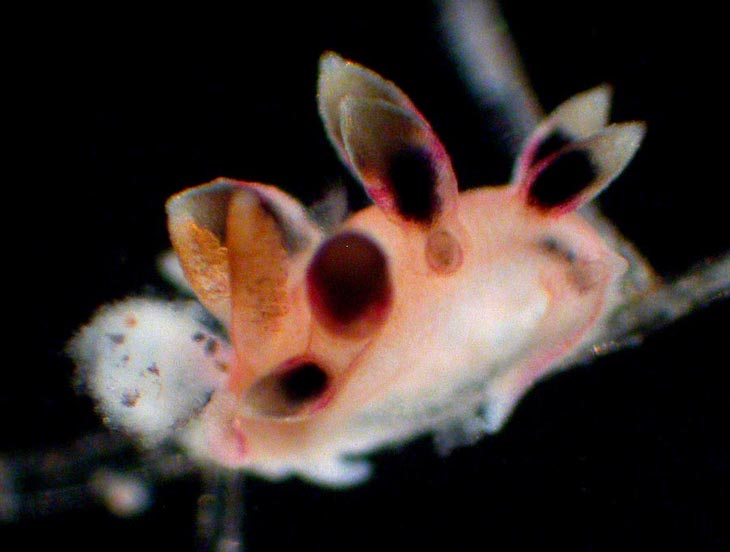 |
David Caron Reunion, 11 February 2005, size : 5 mm
May be a juvenile of Coryphellina exoptata according Hsini Lin and a juvénile of Coryphellina sp. according Bernard Picton |
Florence Trentin C. exoptata crawling or eating on hydroids ? Reunion, "Les brisants" Etang salé les bains, 3 m, in an anfractuosity of the reef, 30 January 2005. Size : 25 mm According to Nicole Gravier-Bonnet (Hydroids specialist from Reunion Island University), the hydroids seems to be an Eudendrium Sp. F exoptata, eats all the external tissue, it's only remain the hydroid skeleton |
|||
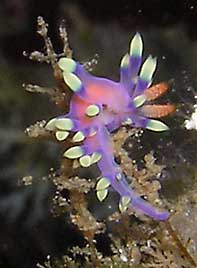 |
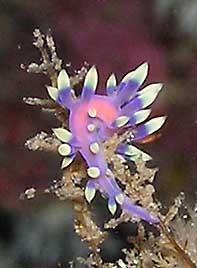 |
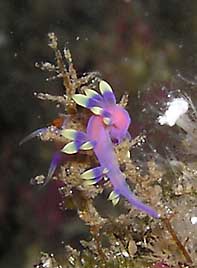
|
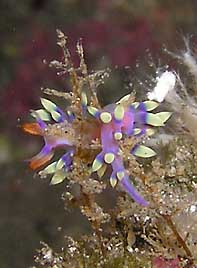 |
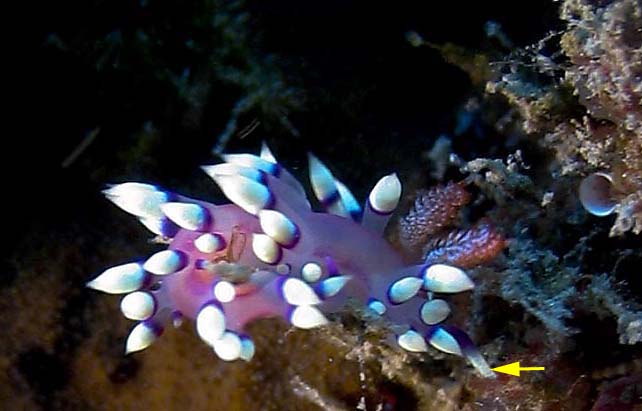 |
David Caron
Reunion, 25 April 2007, Cap la Houssaye at Saint paul, 6 m, size : less than 10 mm. In this specimen the outer third of the oral tentacle is opaque cream like the cerata tips... |
Sophie Darnis Reunion, "Maison verte" at Saint Leu, 26 March 2006. However in some specimen from Aldabra atoll (Gosliner, 1990) and other country (Rudman and Nudipixel), there is no opaque pigment on the outer portion of the tentacles and their are the same colour as the rest of the body This is the case of this specimen and others found in our region ... |
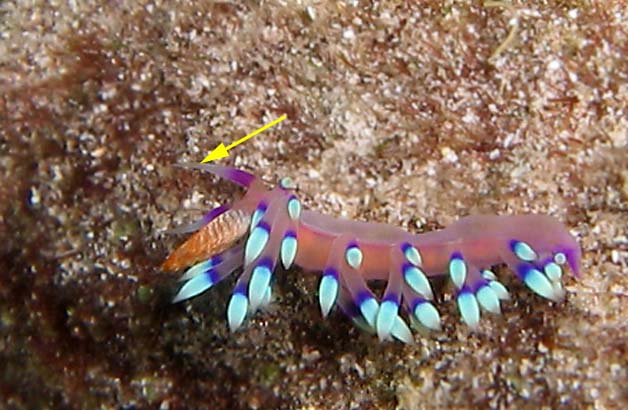 |
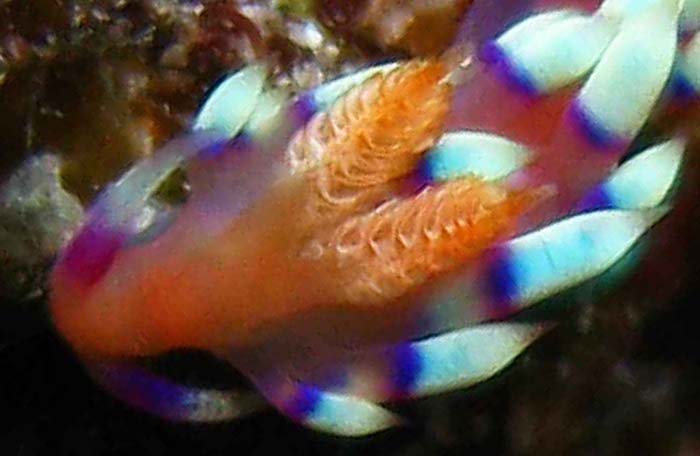 |
Raphaël Roland Gosselin Reunion, "Les arches" Saint leu , 10 m, 9 July 2009, size : 20 mm Detail of the bright orange papillae rhinophores |
Fabrice Schubert Mayotte, Sasiley, 30 m, 22 May 2010 It has numerous papillae (a) on the posterior side of the rhinophores that are bright orange with yellow spots which are caracteristic of this species Specimen with a pale body coloration... The anterior foot corner are enlarged and tentacular, and usually recurved posteriorly (b) when the animal is crawling. In this specimen purple pigment is present on the basal portion of the foot corners (b) (not the apical like in Gosliner description). |
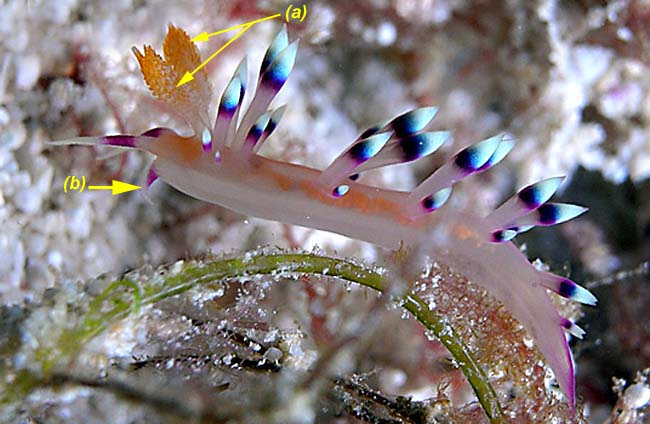 |
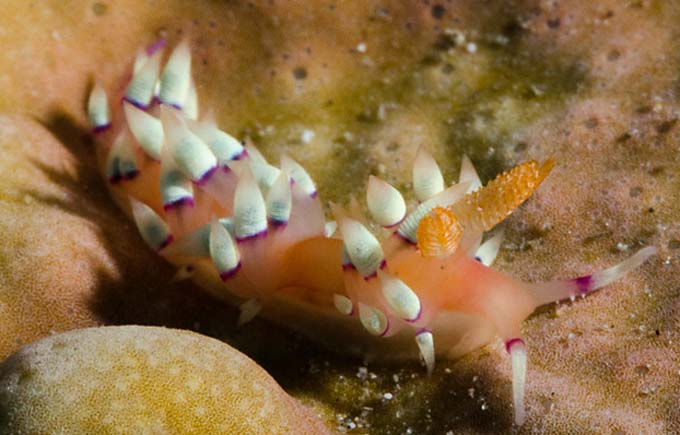 |
Nicolas Noël Réunion, Sainte Rose, 15 m, December 2012, size : 10-12 mm
Specimen with a very limited color purple ... |
Alain-Benoît Rassat Madagascar, Anemone, Nosy Bé, 14 m, 10 December 2015, size : 15 mm
|
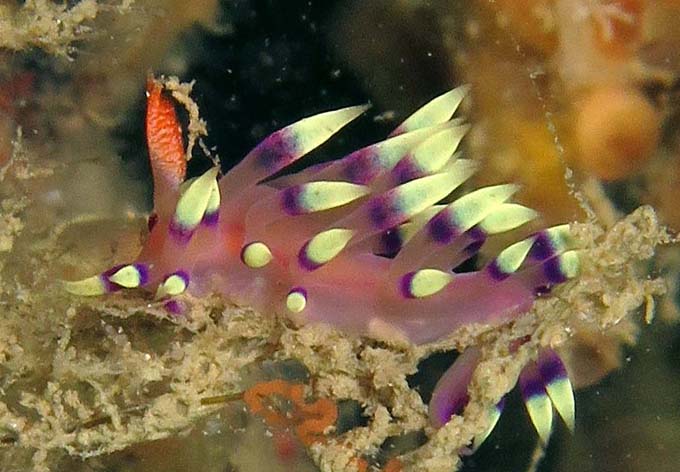 |
More photos from Indian Ocean
See more about : Coryphellina exoptata variability in Southwest Indian ocean
Reunion, foot corner of Coryphellina exoptata, at Saint Paul, by Sully Bachel
Reunion, two Coryphellina exoptata, at Saint Paul, by Alain Diringer